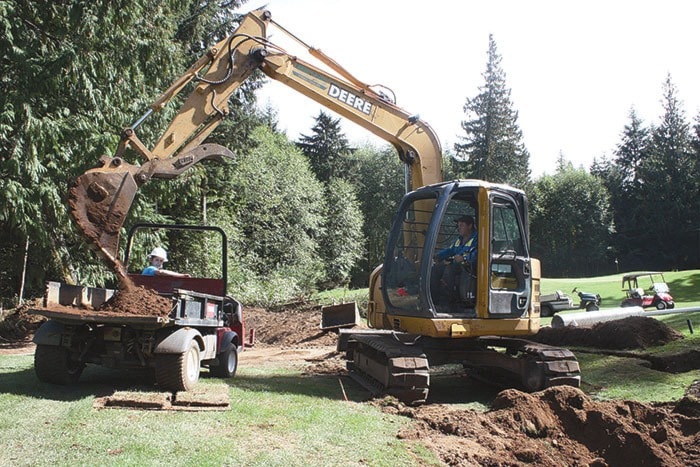Dump trucks and excavators are busy working at Storey Creek Golf Club to replace a man-made water channel to help juvenile coho make their way to a pond just off the greens.
The project, which is being funded by the Campbell River Salmon Foundation, Storey Creek Golf Club, and Nyrstar Myra Falls operation, is within the Woods Creek watershed and is located adjacent to the 14th hole on the golf course.
Gord Lawrence, a surveyor working on the project, said that currently the fish are being thwarted by the elevation of the existing man-made channel in reaching the 300 metre long pond which lies to the west of the 14th fairway.
“The fish come up and there’s too much elevation so they can’t jump up the way it is,” Lawrence said. “We’re going to make a new man-made ditch so the fish can get up to the pond which is good fish habitat.”
The pond is groundwater fed with very little water level fluctuations throughout the year.
The pond is home to a small population of cutthroat trout and has been used for the headwater planting of coho fry from the Quinsam Hatchery by Fisheries and Oceans Canada staff for at least 20 years. The pond, while it is man-made, has all the elements needed for rearing salmonids and boasts the greatest amount of off-channel rearing in the upper part of the Woods Creek watershed.
But a migration barrier 30 metres downstream of the narrow channel which connects to the pond, is making it difficult for the fish to reach the pond.
The barrier is a one metre vertical drop down into a wooden flume, roughly 100 metres long, which is not a suitable habitat for the fish as the sides of the flume are rotting and starting to collapse.
The new bypass, however, will divert the fish around the impediment.
The new channel will have a slope ranging from 0.5 - 4.4 per cent and have a combination of riffles and shallow pools with a gravel substrate. With the barrier removed, juvenile coho from the lower parts of Woods Creek will be able reach the pond and use it as overwintering habitat; the new channel is expected to provide more in stream habitat.
While the work is being carried out, the original channel remains in place.
Once construction is complete on the new bypass, the original channel will be filled in and the flow will be directed into the new channel.
